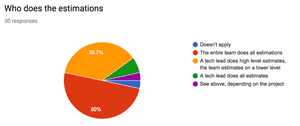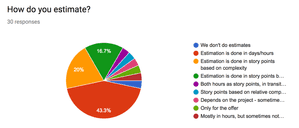Friday 15 December 2017
Estimations - Amazee Agile Agency Survey Results - Part 7
This is part 7 of our series processing the results of the Amazee Agile Agency Survey. Previously I wrote about defining work, this time let’s focus on estimations. How do you estimate and who does estimations in your teams?
ESTIMATIONS
First, we asked about how teams estimate. 43.3% of the contestants answered “Estimation is done in days/hours”, 20% say “Estimation is done in story points based on complexity” and 16.7% mentioned, “Estimations in done in story points based on effort”. The remaining answers of 3% each varied in different degrees of combined estimations, i.e. teams would estimate on a higher level using story points and compare then against hour based task estimations. Also one of the 30 contestants answered that they don’t do estimates at all. For some background information, you can refer to this article on story points.
At Amazee we do two different kinds of estimations. We estimate in days for the offers that we create and put a general price tag below the contract. This is intended to fix a budget but not to guarantee an exact feature set to be delivered. When we go to the implementation phase, teams estimate Jira tickets using story points. The story points are based both on complexity and effort, based on our velocity we can related story points to a price tag and compare against the initial offer and how much budget is left.
We also asked about who is involved in estimation. 50% say that “the entire team does all estimations”, 36.7% mentioned that “a tech lead does high-level estimates, the team estimates on a lower level”. 6.7% say that “a tech lead does all estimates”. For us, at Amazee we tend towards having a tech lead doing high-level estimates and having the team estimate on individual stories and tasks which get prepared for a sprint to work. The tech lead role can be fulfilled by any developer of a Scrum team and may change however the team and the team lead decide it would work best. More complex offers get challenged by multiple developers, more straightforward suggestions will be estimated by only one developer together with the PO. All proposals get reviewed by management. When the team does estimations, we do them along with the entire Scrum team. In some instances, we will limit the number of people in estimation meetings to find a balance between shared knowledge and how much time can be spent discussing as a group of people. How do you estimate? Please leave us a comment below. If you are interested in Agile Scrum training, don’t hesitate to contact us. Stay tuned for the next post where we’ll look at client interactions.


